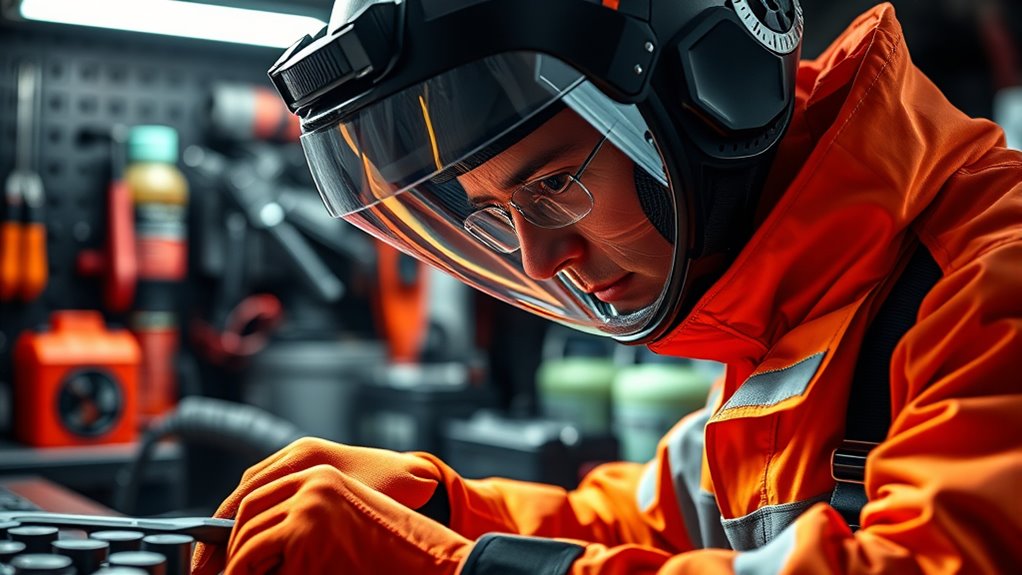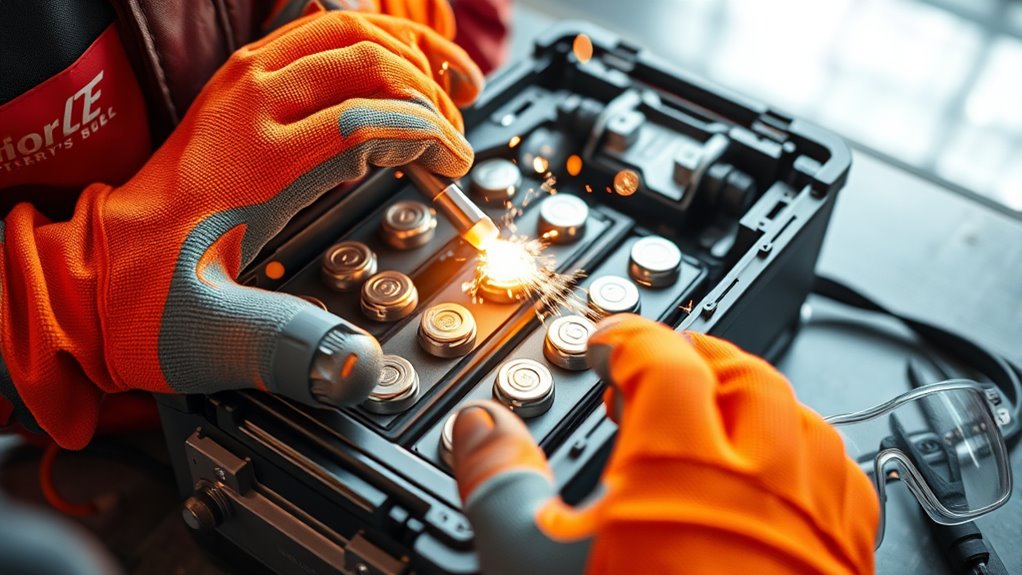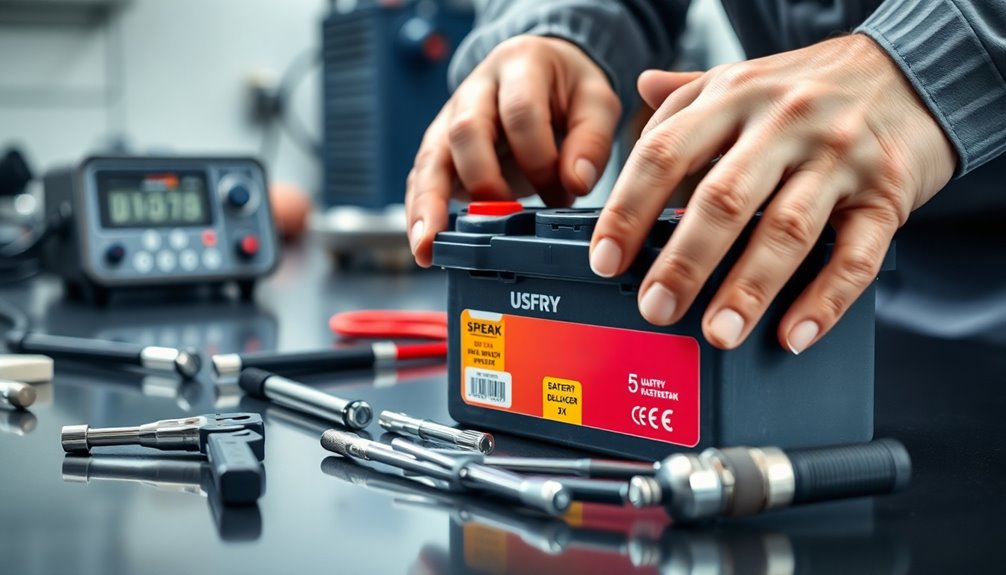When reviving batteries, always wear acid-resistant long sleeves, chemical-resistant gloves, and safety goggles or a face shield to prevent chemical burns and splashes. Use proper respirators in enclosed areas to avoid toxic fumes and make sure good ventilation to reduce explosive gases. After working, carefully remove your gear and thoroughly clean your skin and clothing. Keeping safety gear in top condition and understanding hazards helps protect you—you’ll discover more precautions ahead.
Key Takeaways
- Wear acid-resistant long-sleeved clothing and chemical-resistant aprons to prevent skin contact with hazardous battery chemicals.
- Use safety goggles or face shields to protect eyes and face from splashes and corrosive vapors.
- Ensure good ventilation or use respirators when working in enclosed spaces to avoid inhaling toxic fumes and explosive gases.
- Inspect protective gear regularly for damage and replace worn or damaged equipment immediately.
- Thoroughly clean skin and clothing after handling batteries and carefully remove protective gear to prevent contamination.

Reviving a dead or failing battery can be risky without proper protection, as hazardous chemicals and explosive gases may be released during the process. This is why understanding chemical safety is essential when working with batteries. You need to be aware that sulfuric acid, lead, and other toxic substances can cause severe burns or health issues if they come into contact with your skin or eyes. Before you begin, make sure you have the right protective gear to minimize these risks. Wearing protective clothing is necessary—it acts as a barrier against splashes, fumes, and accidental leaks. Long-sleeved, acid-resistant gloves protect your hands, while a chemical-resistant apron or coveralls shield your body from spills. Safety goggles or a face shield are also critical to prevent any corrosive material from reaching your eyes or face, especially when handling acid or working in confined spaces where splashes are more likely.
When handling batteries, always work in a well-ventilated area. This reduces the buildup of explosive gases like hydrogen, which are released during charging or when the battery is damaged. Adequate ventilation also helps prevent the inhalation of harmful fumes. But even with good ventilation, your protective clothing remains an essential line of defense. It’s not enough to just wear gloves; you should also consider a respirator mask if you’re working in an enclosed space or if the battery shows signs of leakage or damage. Remember, chemicals can linger on your clothing and skin, so avoid touching your face or eating until you’ve thoroughly cleaned yourself after the task. Additionally, understanding the contrast ratio of your protective gear can help you select the most effective materials for different chemical exposures.
Always inspect your protective gear before starting. Worn-out gloves or torn coveralls won’t provide the protection you need. If you notice any signs of damage or contamination, replace them immediately. When removing protective clothing, do so carefully to avoid contaminating your skin with residues. Wash your hands and any exposed skin thoroughly after completing the battery revival process. Proper storage and disposal of used protective gear are also important to prevent environmental contamination or accidental exposure later on.
Frequently Asked Questions
Can I Revive a Damaged or Leaking Battery Safely?
Reviving a damaged or leaking battery isn’t safe. You risk chemical leaks or explosions, so it’s best to handle battery disposal properly. If you must work near it, wear protective gear and prepare for emergency evacuation if needed. Always consult safety guidelines, and never attempt to revive a compromised battery without proper training. Prioritize safety and consider professional disposal services for hazardous batteries.
What Should I Do if Protective Gear Gets Contaminated?
If your protective gear gets contaminated, don’t panic; it’s manageable. First, remove the gear carefully without touching contaminated areas, then perform contaminant removal by thoroughly cleaning the gear with appropriate cleaning solutions. Always follow manufacturer instructions for protective gear cleaning to guarantee safety. Proper cleaning prevents cross-contamination and maintains your safety gear’s integrity, so you can continue working safely and confidently in future battery revival tasks.
Are There Specific Brands of PPE Recommended for Battery Revival?
When choosing PPE for battery revival, you might wonder about brand recommendations and PPE quality. Look for trusted brands known for high-quality protective gear, such as 3M, Honeywell, or DuPont, which offer reliable gloves, goggles, and respirators. Prioritize PPE that meets safety standards like OSHA or ANSI. Investing in quality gear guarantees better protection, so don’t compromise on brand reputation or certification—your safety depends on it.
How Often Should I Replace My Personal Protective Equipment?
You might think PPE lasts forever, but alas, even protective gear needs love. You should regularly check your PPE for wear and tear, following a strict replacement schedule. Generally, replace gloves and eye protection every few months, or immediately if damaged. Proper PPE maintenance and timely replacement guarantee your safety isn’t a gamble. Don’t wait until it’s too late; stay safe by staying on top of gear upkeep.
Is It Safe to Revive Batteries in Confined Spaces?
Reviving batteries in confined spaces isn’t safe due to ventilation concerns and chemical exposure risks. Limited airflow can cause dangerous fumes to accumulate, increasing the chance of inhalation hazards or explosions. You should always guarantee proper ventilation and wear appropriate personal protective gear. If possible, perform battery revival outdoors or in well-ventilated areas, and never underestimate the importance of safety precautions to protect yourself from harmful chemicals.
Conclusion
So, next time you’re reviving a battery, remember: safety gear isn’t just a fashion statement. It’s your superhero cape against sparks, acid splashes, and unexpected explosions. Skip the gloves and goggles, and you might just find yourself starring in your own science fiction thriller—minus the fun. Stay protected, stay alive, and keep your battery revival adventures drama-free. After all, risking a quick zap isn’t worth turning your garage into a hazardous zone. Play it safe—your future self will thank you.










